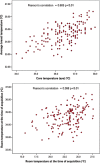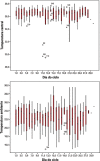Reference breast temperature: proposal of an equation
- PMID: 26761549
- PMCID: PMC4878624
- DOI: 10.1590/S1679-45082015AO3392
Reference breast temperature: proposal of an equation
Abstract
Objective: To develop an equation to estimate the breast reference temperature according to the variation of room and core body temperatures.
Methods: Four asymptomatic women were evaluated for three consecutive menstrual cycles. Using thermography, the temperature of breasts and eyes was measured as indirect reference of core body and room temperatures. To analyze the thermal behavior of the breasts during the cycle, the core body and room temperatures were normalized by means of a mathematical equation.
Results: We performed 180 observations and the core temperature had the highest correlation with the breast temperature, followed by room temperature. The proposed prediction model could explain 45.3% of the breast temperature variation, with variable room temperature variable; it can be accepted as a way to estimate the reference breast temperature at different room temperatures.
Conclusion: The average breast temperature in healthy women had a direct relation with the core and room temperature and can be estimated mathematically. It is suggested that an equation could be used in clinical practice to estimate the normal breast reference temperature in young women, regardless of the day of the cycle, therefore assisting in evaluation of anatomical studies.
Objetivo: Desenvolver uma equação de estimativa da temperatura de referência das mamas, de acordo com a variação das temperaturas ambiente e central.
Métodos: Foram avaliadas quatro mulheres assintomáticas durante três ciclos menstruais consecutivos. Mensuraram-se, por termografia, as temperaturas das mamas e ocular, como referência indireta das temperaturas central e ambiente. Para análise do comportamento térmico durante o ciclo as temperaturas das mamas, foram normalizadas com a temperatura central e ambiente por meio de uma equação matemática.
Resultados: Foram realizadas 180 observações, sendo que a temperatura central apresentou a maior correlação com a temperatura das mamas, seguida da temperatura ambiente. O modelo de predição proposto conseguiu explicar 45,3% da variação da temperatura das mamas com temperatura ambiente variável podendo ser aceito como uma forma de estimar a temperatura de referência das mesmas em diferentes temperaturas ambientais.
Conclusão: A temperatura média das mamas em mulheres saudáveis teve relação direta com a temperatura central e ambiente, e pôde ser estimada matematicamente. Sugere-se que uma equação poderia ser utilizada para estimativa da temperatura de referência da mama normal em mulheres, independente do dia do ciclo e, portanto, auxiliar na avaliação de estudos anatômicos.
Conflict of interest statement
Conflict of interest: none.
Figures










References
-
- Connell JF, Jr, Ruzicka FF, Jr, Grossi CE, Osborne AW, Conte AJ. Thermography in the detection of breast cancer. Cancer. 1966;19(1):83–88. - PubMed
-
- Isard HJ, Becker W, Shilo R, Ostrum BJ. Breast thermography after four years and 10000 studies. Am J Roentgenol Radium Ther Nucl Med. 1972;115(4):811–821. - PubMed
-
- Gautherie M, Gros CM. Breast thermography and cancer risk prediction. Cancer. 1980;45(1):51–56. - PubMed
-
- Frize M, Herry C, Roberge R. Processing of thermal images to detect breast cancer: comparison with previous work, “Enginnering in Medicine and Biology, 2002; 24 th Annual Conference and the Annual Fall Meeting of the Biomedical Engineering EMBS/BMES Conference; 2002; 2002. pp. 1159–1160. Proceedings of the Second Joint.
MeSH terms
LinkOut - more resources
Full Text Sources

